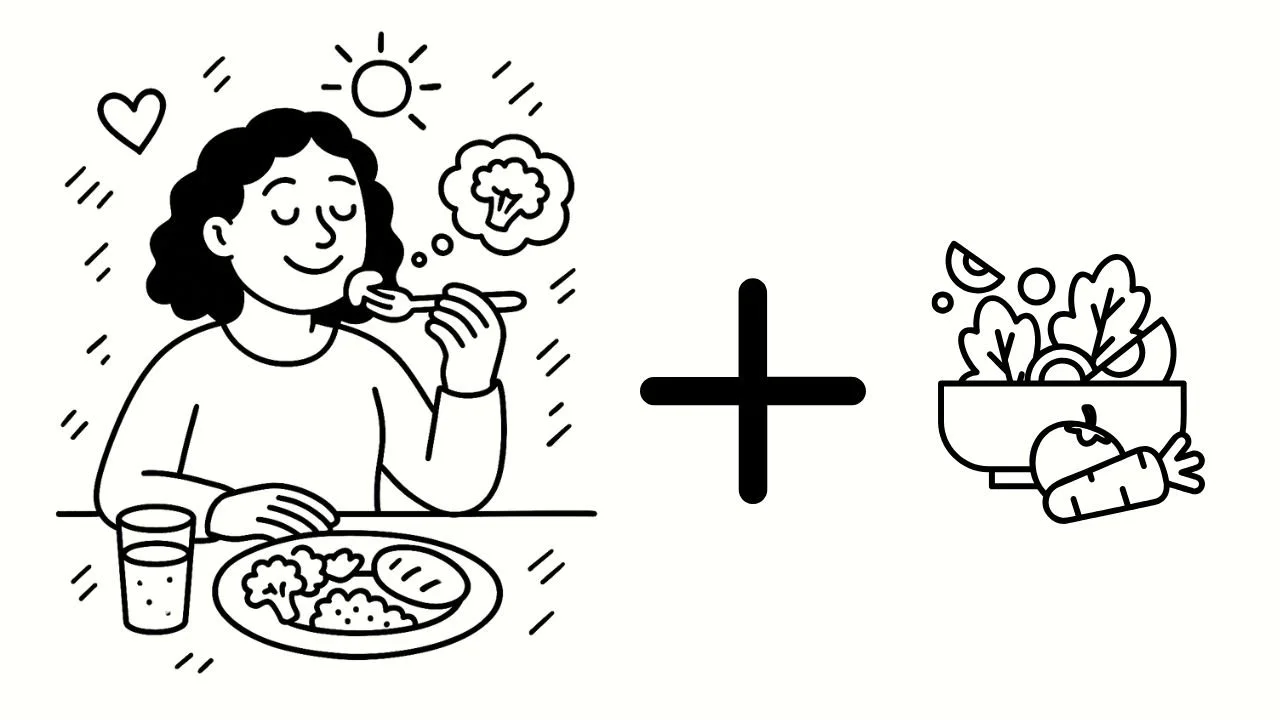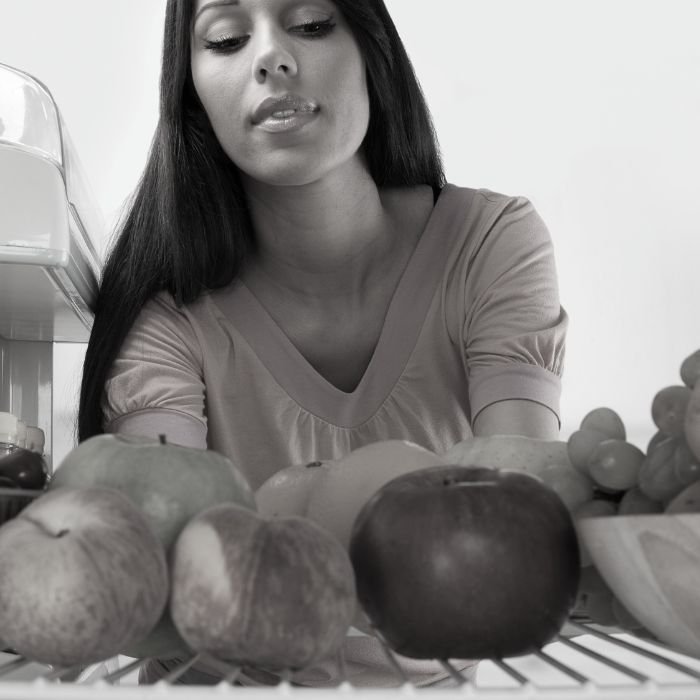Eat better without obsessing about food
This guide isn’t theory. It’s shaped by years of coaching sessions, real conversations, and the practical shifts that people tested until they found what actually works.
You’re here because eating well shouldn’t feel like a full-time job.
Maybe you’ve tried to eat “better” before. You cut out sugar, counted macros, meal prepped like a pro… until life got messy or you just couldn’t keep it up anymore. Then came the guilt spiral (and maybe the late-night snack raid).
If food feels like a source of stress, instead of nourishment, it’s not because you’re doing anything wrong. You’ve probably just been taught to focus on rules instead of rhythm, discipline instead of trust.
This page will guide you through a new approach.
You’ll reflect on what’s really making food feel complicated, explore ways to eat in a way that supports you without triggering guilt or obsession, and get access to deeper support if you want to make lasting change.
Step 1: Reflect on your diet
Why food feels so complicated
If food feels like a minefield, you’re not imagining it.
We live in a culture that treats food as a moral issue, labeling choices as “good” or “bad” and expecting perfection. No wonder eating can feel heavy.
Think about this:
Food guilt is a reflection of culture, not character.
That shame spiral after eating a cookie? It’s not about willpower. It’s about years of diet culture messaging that taught you to judge your worth based on what’s on your plate.When food feels overwhelming, it’s often a sign of disconnection, not failure.
You’ve likely absorbed so many outside rules that it’s hard to tune in to what you actually need. The first step isn’t to overhaul your diet, it’s to rebuild that inner trust.It’s not you, it’s the noise.
Constant conflicting advice makes it hard to know what’s “right.” The shift? Move your thinking from “What should I do?” to “What helps me feel steady and cared for right now?”
Reflection activity
This section is designed to help you reflect on where your food mindset comes from and why the pressure to “get it right” often backfires.
Ask yourself these questions:
What food “rules” do I follow, even when they make me feel worse?
When did I first learn to judge myself for what I eat?
How do I want to feel when I think about food?
Step 2: Take action and start eating better
Start eating in a way that feels supportive (not obsessive)
You don’t have to fix your food. You can shift your approach.
Forget rigid routines and picture-perfect meals. Eating better doesn’t have to mean overhauling your life. It can mean paying attention to what helps you feel steady, energized, and cared for. You get to define what that looks like.
Consider:
Food isn’t just fuel, it’s connection, comfort, and culture too.
When you stop judging and start noticing what actually supports you, food becomes something that grounds you, not something to “get right.”You’re allowed to make food choices based on ease, not just nutrition.
Nourishment includes grace. Sometimes it’s a veggie stir-fry. Sometimes it’s frozen waffles and breathing room. Both count.Listening to your body doesn’t mean overthinking every bite.
You don’t have to micromanage. A simple question, “Will this help me feel steady or cared for?” can anchor you better than any meal plan.
Take a baby step
Try two tiny shifts to ease into food peace:
1. Add one “feel-good” food to your next meal
Instead of cutting something out, try adding something in: a food that helps you feel nourished, steady, or comforted. It could be something crunchy, colorful, warm, or familiar. (Yes, toast counts.)
Why it helps: Shifting the focus from restriction to addition builds trust and lowers resistance. You're not “fixing” anything, just listening to your body a bit more closely.
2. Pause before eating, not to assess, but to notice
Before your next snack or meal, take 10 seconds to breathe and ask: What do I need right now? It might be food, it might be quiet, or it might be both.
Why it helps: Creating a soft pause can help you reconnect with your body, not as a rule, but as a grounding moment. It’s not about eating “right.” It’s about tuning in, gently.
Add nutrition: A fast and easy approach to healthy eating
Focus on adding, not taking away
When it comes to transforming your eating habits, everyone seems to be trying to push you toward cutting out "bad" foods. I’ve tried that. It sucks. And it gave me an idea.
What if you shifted your focus from what you should eliminate to what you can abundantly add?
This idea can change not only what’s on your plate but also your overall approach to eating. Here’s a deeper dive into why adding nutrition, rather than subtracting temptations, could be your best strategy for a healthier lifestyle.
The power of positive eating
The core idea here is simple. By concentrating on adding healthy, nutrient-dense foods to your diet, there's naturally less room for the not-so-great options. This doesn't mean you can't ever indulge in your favorite treats; it simply shifts the balance towards healthier choices more often. This mindset seems much healthier to me than restrictive eating because it’s centered on abundance and satisfaction rather than focusing on what you can’t have.
Eat to feel full AND fulfilled
Nutrient-rich foods like leafy greens, colorful fruits, hearty whole grains, and lean proteins do more than nourish—they satisfy. These foods are typically higher in fiber and protein, which are the champions of satiety. They help keep you fuller longer, which means you're less likely to find yourself rummaging through the pantry for a not-so-healthy snack an hour after dinner.
Add a spectrum of nutrients
Every additional serving of fruits or vegetables packs a punch of vitamins, minerals, and other essential nutrients, elevating the nutritional quality of your meals. Think about how your body works. You need to give it nutrients so that it functions the way it should. Feeding it properly is likely to translate into noticeable benefits such as smoother digestion, more consistent energy levels throughout the day, and a more robust immune system. (And who wouldn't love fewer sick days?)
Give yourself a psychological edge
Changing your diet can often feel like a losing battle with willpower. However, when the focus is on adding rather than restricting, it fosters a healthier relationship with food. Think of it as a psychological trick; you’re not constantly feeling deprived or punished. Instead, you’re rewarding your body with what it needs. This can drastically change how you view mealtime: from a challenge to a celebration of good choices.
Transition naturally to healthier eating
By introducing more wholesome foods into your diet, you might naturally begin to prefer them over less healthy options. Over time, this can lead to a spontaneous reduction in unhealthy foods without the struggle of abrupt cuts. You’re taking a gentle pivot rather than a sharp turn, which is often more sustainable in the long run.
Discover new foods and delight your palate
There's a whole world of foods out there you might not have tried yet. From exotic fruits to ancient grains, expanding your palate can turn eating healthily into a culinary adventure. Experimenting with new recipes and ingredients keeps meals exciting and engaging—it’s a far cry from the monotony that often comes with strict dieting.
Craft your plate with purpose
So, how do you start? Begin by simply adding one extra serving of vegetables to every meal. Maybe throw some spinach into your morning smoothie (it might turn green, but I promise you won’t taste it!), or add a colorful salad to your dinner. Gradually, as your comfort with these foods grows, so will their presence on your plate. It's not about perfection; it's about progression.
Remember, changing your diet doesn't have to be an exercise in restriction. By focusing on adding healthful choices and the joys of new, nutritious (and sometimes tasty!) discoveries, you create a diet that's not only good for your body but also tastes great and makes you happy. Give it a try and let me know in the comments below whether it’s an easier way to approach healthy eating.






